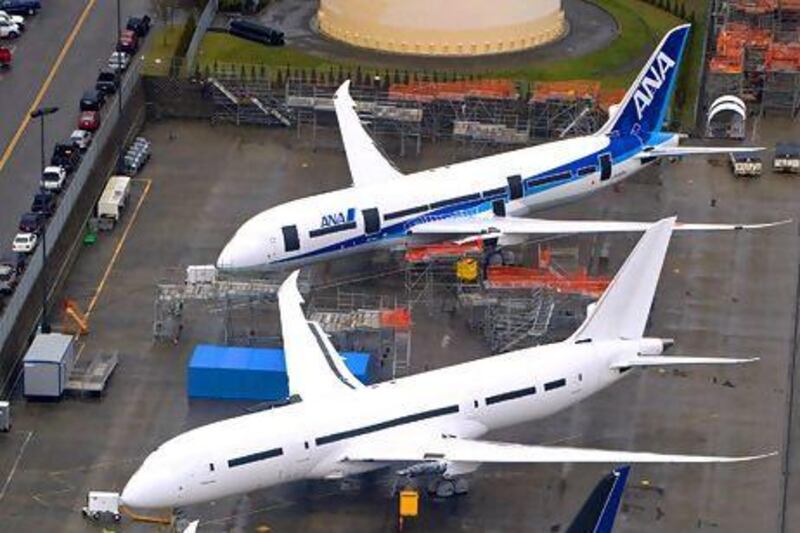Time was, there were two main rules to investing: keep your portfolio diverse … and don't invest in the airline industry.
However, if over the past six months you had chosen to ignore rule two, you would be sitting on a tidy windfall now.
Bloomberg's global airline index gained 28 per cent between mid-November and mid-March; Morgan Stanley Capital International's (MSCI) equivalent index was 22 per cent up.
Now, however, both measures are down by 6 to 8 per cent from their peaks. Whether this is a blip in the upward trend, or a return to the moribund status quo remains to be seen. What is certain, however, is that both premises will be tested in the coming weeks by a series of events in the pipeline.
For a start, the results of test flights to evaluate Boeing "fix" for the battery problem that grounded its 787 Dreamliner in January are being passed to the federal aviation administration (FAA) in the United States.
Boeing needs the FAA to end its grounding order, imposed after a series of fires aboard the next generation airliner caused by overheating lithium batteries, so deliveries can resume from an order book valued at almost US$190 billion.
Boeing has to restart deliveries to pare a backlog of about 800 planes, with a list price starting at $206.8 million. It already has teams in Japan, where All Nippon Airways and Japan Airlines fly almost half of the 49 planes in service, to prepare to install new batteries once approval is granted.
"This will move really fast in terms of being able to get the airplanes back into the air," said Ray Conner, the president of Boeing Commercial Airplanesat a conference last month.
Regulators won't be rushed, however, because there is also political pressure as well as the safety issue at stake. The FAA's role in approving the cells for the Dreamliner in 2007 will be the focus of a two-day US National Transportation Safety Board hearing starting on April 23, and this week, the Dreamliner will probably come up when a US Senate committee holds a hearing to discuss the FAA's progress on safety initiatives.
But if the FAA does not approve, Boeing has a big problem, said Richard Aboulafia, a Teal Group analyst. "Even if there's only a 5 or 10 per cent chance that it won't satisfy the FAA, that's a big risk, especially if there isn't a back-up plan," he said.
There's also a chance that the FAA may shorten the distance that the Dreamliner is able to fly from the nearest airport. The 787 is now cleared for Etops, or extended operations, flights that require it to be within 180 minutes from the nearest diversion airport in case of emergencies. Even a temporary reduction would limit the jet's use on the long-haul routes for which it was designed, said Ken Herbert, an analyst at Imperial Capital.
So far, investors have been supportive of Boeing. The shares have risen sharply - up to 13 per cent - since January 4, the last trading day before the fire on the Japan Airlines plane. That topped the 8.3 per cent gain for the Standard & Poor's 500 Index. The FAA approved Boeing's approach to fixing the battery system in March. The market's continued indulgence will depend on whether the FAA will approve the actual fix.
Other issues are also dragging on the industry. The latest bird flu outbreak in China seems to have rattled nerves by dredging up memories of the Sars scare a decade ago. But investors may take some comfort from the fact that the Sars impact proved short-lived. Yes, airlines took a big hit, with the MSCI World Airlines index diving 17 per cent in the first weeks. But over the entire event it actually rose 4 per cent.
Then there is North Korea.
The outlook continues to be glum for North American carriers. March trading updates from Delta and US Airways were disappointing, with revenue implications from federal budget cuts blamed. But this is hardly news.
However, for the European airline market, particularly the low-cost carriers on short-haul routes, the outlook is marginally more optimistic. Restructuring by flag carriers and the demise of some smaller airlines means that capacity has been reduced over the recent northern winter so the seat growth prediction this summer of a modest 2 to 3 per cent will not be quite so damaging.
Globally, the long-term picture is also brightening. Last month the International Air Transport Association (Iata) said airlines were on course for improved profits because of higher-than-expected passenger travel and a recovery in air cargo markets. It upgraded its closely watched industry performance forecast, saying it expected airlines to record a combined net profit of $10.6bn this year, up from a previous estimate of $8.4bn.
Iata said passenger air travel was expected to increase faster than previously expected, complemented by a return to modest growth in air cargo after two years of decline.





